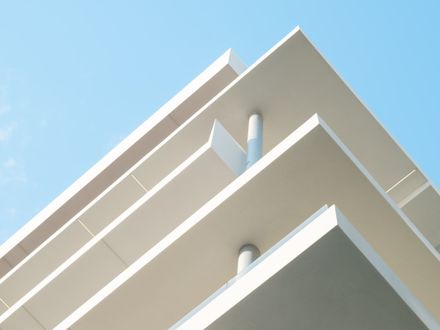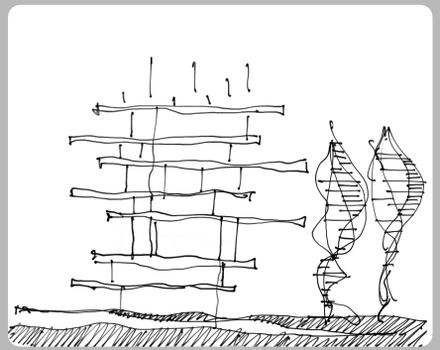
De Amicis 154 Residencial Building
ARCHITECTS
Giovanni Vaccarini Architetti
CONSTRUCTION SITE MANAGER
Raffaele Mancinelli
MECHANICAL ENGINEERING
Beta Srl
ART DIRECTION
Giovanni Vaccarini
MAIN CONTRACTOR
Elea Srl
PROJECT TEAM
Giovanni Vaccarini, Matteo Preite, Herman Carbonetti
STRUCTURAL ENGINEERING
Lorenzo Rinaldi
CONSTRUCTION MANAGER
Antonello Ricci
PHOTOGRAPHS
Anna Positano, Gaia Cambiaggi
AREA
1300 M²
YEAR
2025
LOCATION
Italy
CATEGORY
Apartments
Text description provided by architect.
The new building at Via De Amicis 154, designed by Giovanni Vaccarini Architetti in the center of Pescara, reinterprets the concept of a residential structure, blending traditional typology with a more direct connection to the urban environment.
The new building at Via De Amicis 154, designed by Giovanni Vaccarini Architetti in the center of Pescara, reinterprets the concept of a residential structure, blending traditional typology with a more direct connection to the urban environment.
Conceived as a series of overlapping residences, the new architecture by Giovanni Vaccarini opens onto the city through spacious terraces that extend variably around a central core.
The building's ground level steps back from the street frontage, occupying only a minimal portion of the lot and creating the conditions for continuity with the surrounding public space. The center of Pescara is built on a modern urban fabric where the Adriatic coast and its linear development serve as a key reference.
Giovanni Vaccarini, whose studio has been based in Pescara for many years, has repeatedly explored his architectural ideas within this context and the cultures that have shaped it.
Vaccarini—an influential figure in Italian architecture—has developed numerous works and projects examining the interplay between private and public spaces, spanning diverse building types and scales: residences, schools, stadiums, energy production facilities, and hospitals.
For Vaccarini, the city of Pescara is a place of experimentation, where he can modify established typologies. The palazzina, a multifamily residential building and a focal point of his research, is one such typology.
The new building at Via De Amicis 154 is located close to Riviera 107, completed two years prior along Pescara's seafront, where Giovanni Vaccarini had already begun exploring his reinterpretation of the palazzina within the Adriatic context.
That earlier project drew attention from the press and critics, not only for its original and refined compositional choices but also for its approach to blending the residential building with the public realm of its urban surroundings.
Similar to the new building on Via De Amicis, Riviera 107 did not confine itself within a private boundary nor assert itself along the street frontage. Instead, it found a hybrid, intermediate solution that redefined the building's role within the city.
This approach opens up the architecture to engage with its context, challenging the traditional separation of private and public space.
This new work by Giovanni Vaccarini is located on the corner of an urban block near the coast, just a short distance from the central Piazza Salotto.
Surrounded by treelined avenues and several architecturally significant buildings, the palazzina at Via De Amicis embodies a contemporary vision with a strong emphasis on connecting with the surrounding urban fabric and public space.
The building emerges as a series of stacked planes with lush terraces that fully encircle the apartments, projecting toward the city in multiple directions.
The inhabited spaces seem to expand centrifugally around the building's central core, which has a minimal footprint at ground level, creating a dynamic interplay of extension and contraction.
This configuration takes advantage of sightlines and establishes visual and spatial connections with the surrounding area, creating an engaging, outward-looking relationship with its environment.
Viewed in plan at street level, the building presents a compact central core that occupies only a portion of the buildable lot.
This central area primarily serves as an entrance to the upper floors and features a pathway that continues the sidewalk, inviting visitors to move through the volume from one side to the other.
On the upper levels, this concept is reversed, with each floor expanding to varying extents, creating a building profile that is both open and dynamic.
Vaccarini's approach to this project aims to reinterpret the block building type, incorporating a unique distribution concept shaped by unexpected sea views and its urban context.
As a result, the palazzina takes on the appearance of a striking series of stacked villas. In Vaccarini's work, the observation and emulation of plant forms are often present.
The Via De Amicis building in Pescara, for instance, can be seen as a living organism driven by the need to seek out light, views, and opportunities for connection.
Its six above-ground floors extend variably, reaching outward where the urban environment allows, in search of glimpses of the landscape between the sea and the mountains.
On the northwest side, where the projection is most pronounced, a series of slender steel columns—three single and three paired— stand irregularly.
These columns emphasize the perception of verticality while also contributing to the structural integrity of the building.
The search for contemporary urban space is also evident in the decision to highlight the building with numerous subtle lines of light that radiate from the central core.
Primarily placed in the undersides of the protruding floors, these light lines often continue along the vertical walls, emphasizing the theme of extending the living experience into the city.
In doing so, they not only enhance the building's visual relationship with the surrounding space but also give it a sense of recognition and participation within the public realm.
The search for contemporary urban space is also evident in the decision to highlight the building with numerous subtle lines of light that radiate from the central core.
Primarily placed in the undersides of the protruding floors, these light lines often continue along the vertical walls, emphasizing the theme of extending the living experience into the city.
In doing so, they not only enhance the building's visual relationship with the surrounding space but also give it a sense of recognition and participation within the public realm.
Giovanni Vaccarini is a highly regarded architect known for his work in contemporary residential spaces, blending high-quality composition with innovative designs.
He has long focused on the theme of residential architecture, dedicating significant research to the evolution of the "palazzina" and its role in shaping the Adriatic city's urban landscape.
Vaccarini's contributions extend beyond practice into academic research, particularly in university teaching.
Some of the most recent projects from his firm, Giovanni Vaccarini Architetti, include the Presidio Ospedaliero Giovanni Paolo II in Ragusa, the Istituto Omnicomprensivo Giovanni XXIII in Avezzano, and the Giuseppe Mazzini Middle School in Pescara, which is still under construction. His work continues to influence the architectural scene in Italy.
A new book edited by Manuel Orazi, recently published by Italian publisher LetteraVentidue, offers a critical exploration of the work of Giovanni Vaccarini Architetti and its profound relationship with the Adriatic region, where many of the studio's projects have been built.


































